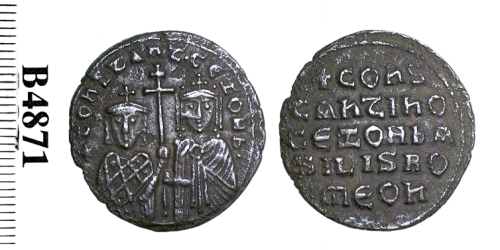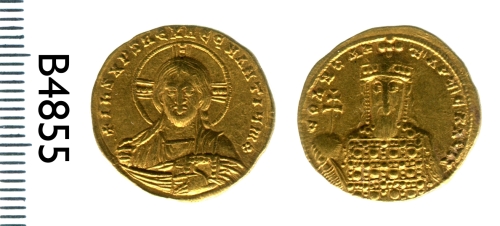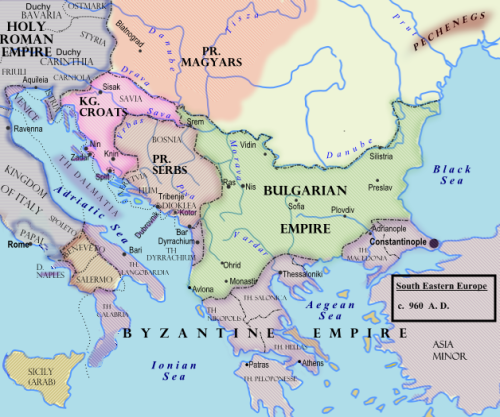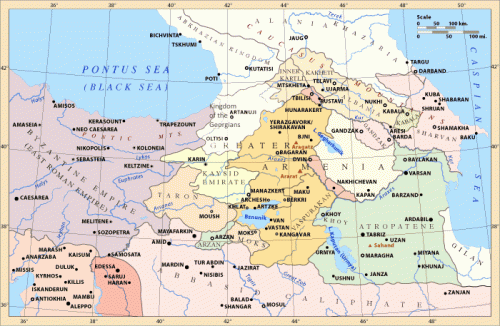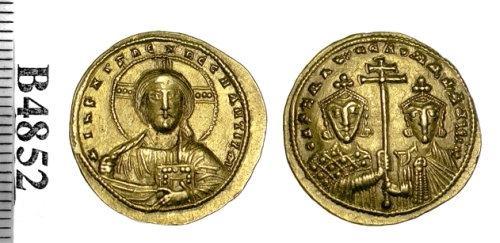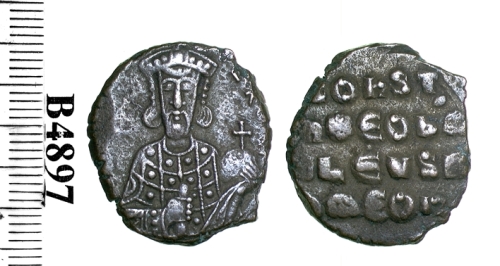The last of these posts, though not the last of the 2015 conference reporting I fear, sees me up bright and early on the 9th July 2015. Why? Well, partly so as not to miss breakfast but also because as you may recall, the previous day had almost all been sessions in honour of Ian Wood to mark his retirement. In fact those sessions continued all the rest of the conference, but for reasons that will shortly become clear, I could only go to the first one, and that meant going to hear one of my undergraduate teachers for whom I long ago developed a practice of being good and prompt. What am I talking about? Witness!
1514. The Early Medieval Church: history and hagiography – sessions in honour of Ian Wood, V
- Rosamond McKitterick, “Reflections on the Manuscript Transmission of Eusebius-Rufinus, Historia ecclesiastica in the Early Middle Ages”
- Barbara Rosenwein, “Feeling Saints in Gregory of Tours”
- Wendy Davies, “Unpicking the Early Strands of Becerro Gallicano of San Millán de Cogolla: the monasteries of old Castile”
- Thomas F. X. Noble, “Response”
As a line-up of people whose work has influenced me this is hard to beat. Rosamond, furthermore, opened all our eyes, I think, by picking up on something that I at least knew but knew very little about, that Eusebius’s famous History of the Church, written in Greek around 312-24, was largely known to the West only in the form of the Latin translation of Rufinus, who made it in 401, he says as a distraction from the depradations of the Goths! Rosamond pointed out that he did not leave Eusebius’s text alone, but combined much of the last two books and added two more of his own, and this involved inserting the Nicene Creed, no less, where Eusebius’s report of the Council of Nicæa had only had the council canons. And this was basically the West’s most stable source for the Creed that is the centrepost of Christian worship. Rosamond had counted ten versions in circulation by the Carolingian era, but Rufinus’s was the most common. You can see why some people felt like a reform was needed, can’t you? Professor Rosenwein, meanwhile, reminded us that despite technically being in Heaven and above such concerns, saints as conceived in the Middle Ages still got angry and upset, lamenting and so forth, in much the ways that their followers on Earth did but for better reasons and with better outcomes; they were to an extent emotional guides for the faithful on how to use one’s feelings for the good. This paper was hampered somewhat by relying solely on Gregory, who may well have had his own emotional spectrum (I would centre it on crotchety entitlement, myself), and in questions Albrecht Diem mischeviously raised the prospect that Gregory had two or more different ideals of sanctity in which case, as Professor Rosenwein said in answer, all generalisation would become impossible. Lastly Wendy, taking advantage of the brand new digital version of the Aragonese monastery of San Millán’s oldest surviving cartulary, had dug into it to detect an initial compilation of geographically-focused dossiers, of which one, but only one, went much back before 1000, that dealing with one valley whose materials were, unlike the rest, not in standard diplomatic form; she characterised this as the diplomatic of breakdown, when the practice of charter-writing continued but no authority was left to require how. This is quite powerful as a tool for me and I need to go and look at those charters, not least because I have observed the same myself at Leire and Obarra without thinking about what it meant.1
Sam Ottewill-Soulsby, none other, closed that session by remarking that the frontier had its own characteristics that were worth seeing from a frontier perspective; little did he know how much of a choir he was speaking to… You see, the reason I couldn’t come to any more of the sessions for Ian Wood, be they never so luminaried, was that my own sessions got going after coffee this day. They were but two, and I could have wished they weren’t so late in the conference since the audience dropped with each one as people went home, but they were still fun and they went like this.
1630. Rethinking the Medieval Frontier, I: beyond the Reconquista
- Álvaro Carvajal Castro, “A Kingdom with no Frontier: on the political identity of the Astur-Leonese monarchy, 9th-11th centuries”
- Jonathan Jarrett, “De administrandis marcis: the 10th-century frontier with Islam seen from Barcelona and Byantium”
- Rodrigo García-Velasco, “Place, Fringe, Society or Process? Rulers and Ruled at the Iberian Frontier through the evidence of the fueros and cartas de población, c. 1050-1150″

Remains of the church of San Benito de Sahagún, on the site of the earlier monastery. Photo by Davidh820 – Trabajo propio, CC BY-SA 3.0 es, https://commons.wikimedia.org/w/index.php?curid=21717489
All three of us entered this session with historiographical beasts to slay, I think. For Álvaro it was the frontier itself: he focused on the Tierra de Campos around the monastery of Sahagún and noted that after it was notionally fully incorporated into the kingdom of Asturias at the end of the ninth century, with royal donations indicating a considerable scale of property in the general area, the kings could still effectively lose control to local strongmen after a while, and the monastery had first to become the kings’ chosen strongman and then, after a further while, to give up on the kings and focus on the counts of Castile for support. This was less a frontier zone than just an ineffectively-governed one (though I might still argue for that as a frontier space, like mountains2). This theme that frontier politics were maybe just like politics elsewhere came up a lot in discussion, and it was fellow contributor Nicholas Paul who drew us back on track by reminding us that what made it different was the possibility of and for warfare, and Rob Portass had already raised this possibility by reminding us that Sahagún suffered sacking by the armies of al-Mansur in the late tenth century, enough as we know to detach many an area from its notional protectors!
Rodrigo’s chosen beast, which has withstood a lot of slaying so far, was the Reconquista. Despite doing the particularly difficult thing of giving a first paper before one’s old supervisor (I taught Rodrigo in Oxford, which was why I had gathered him into this effort), he made an eloquent and even impassioned attempt to use the five-hundred-plus local law codes known as fueros to argue for a fragmented, discontinuous and locally-negotiated process of incorporation of new territories into the Navarrese and Aragonese crowns, a process which military presence and the award of these codes only began, rather than concluding. The results remained at the mercy of local strongmen and contrary offers (meaning, for example, that Tudela, Rodrigo’s particular focus, actually switched from Aragón to Navarre after a while) for a long time after the supposed frontier had moved beyond them. This of course meant that the very processes that Rodrigo here thought defined the frontier were those which Álvaro had used to refute such a definition for Sahagún, so it is perhaps no wonder that the discussion was agnostic about whether we were really looking at a distinct phenomenon, but trying to put some definitional flesh on the skeletal concept of ‘frontier’ was what we were all doing there so that was OK by me.

One manuscript of the fuero of Tudela, Archivo Municipal de Tudela, Pergamins A.0002.3 I think, due to be published by Rodrigo García-Velasco whose image this is
Speaking of me, I was of course the middle one here, and my beast was incomparability. Despite the apparent incongruities of culture, size, resource and agency I was determined to put my year of necessary Byzantinism to use here, which was where all the digging into Constantine VII‘s De Administrando Imperii had come from. Looking at Constantine VII and Borrell II of Barcelona, of course, who just about overlapped but who in the former case were writing of an earlier time, I gave due attention to the disparities but then argued that both leaders seemed to realise that their best strategy for asserting themselves beyond the borders of what they securely controlled was to locate and enlist a subordinate in whom they could really trust and then let them have their head. Borrell laid more conditions down on some of his chosen subordinates (some of whom, like those of the kings of Asturias, were monasteries) and arguably got less out of them, but the attraction and retention of somebody who could actually achieve things for you was apparently worth the price of their working for themselves. This is the kind of ‘rule’ I want this frontiers project to derive and test; how well has this worked when people have done it and are there context-specific factors that explain that? And so on. This was by way of a first try at what I want this project to be.
But, necessarily, such a project cannot be all about the Iberian Peninsula even if that’s where my personal networks are strongest. So there was lunch, and various people fading away and finally, the determined hold-out cohort reconvened for the last session of both conference and strand, as follows.
1730. Rethinking the Medieval Frontier, II: Eastern Europe and Eastern Mediterranean
- Jakub Kabala, “Concepts of the Border in Early Medieval Central Europe”
- Luca Zavagno, “Islands – Not the Last Frontier: Insular Models in the Early Medieval Byzantine Mediterranean, ca. 650-ca. 850
- Nicholas Paul, “The Lord’s Tournament Ground: the performance of nobility in Crusader Outremer”
I was sorry about the small audience for this session, not just because I’d invited these people to speak from far away in all cases and could in the end offer them only a few hearers, but also because there were three quite different and testing conceptions of frontier space in operation, the discussion such as it was was very thought-provoking and I just wish there could have been more people in it. Kuba was dealing with early medieval ecclesiastical language for borders, which, unsurprisingly, was Biblical, coming from Exodus and Proverbs. While these were usually interpreted in commentaries as describing the boundaries of correct belief, beyond which only heretics would go, Kuba had many examples of churchmen invoking them to complain of more basically territorial infractions, Carolingian clerics writing of Brittany and Thuringia, Methodius of Bavarian infiltration of the province of Moravia, and so on. Clearly the Church had a sense of bounded space here, even if a Biblically-phrased one. Predictably, I therefore asked in questions how that space was bounded, given that it didn’t need to be politically controlled or defended and frequently wasn’t, and Kuba wisely said that the key question was who ordained its clerics.

Fresco illustration from San Clemente di Roma, showing the apostles of the Slavs, Saints Cyril and Methodius, before the pope. By anonymous artist – Unknown, Public Domain, https://commons.wikimedia.org/w/index.php?curid=2303590
This got me thinking. It is that nodal concept of territory with which early medievalists now like to play instead of lines on a map, and it could be represented almost fractally, as each individual cleric answering or not answering the claimant authority himself had a congregation composed of villages or even households who might go to him but might instead go to the priest next-door. In some sense, at this lowest level, if you could go back there and ask people which fields and streams were in which farm and so on you could build a map up from these tiny tiles, as indeed people did for the term of Santa Maria de Manresa in 978 in a way that Jordi Bolòs hs since mapped (my example not Kuba’s obviously), but it would be sort of missing the point: the resource demarcated by such lines was the hearts and minds of those behind them, not the stuff up to the edge.3 If such a person crossed that line to go and visit someone, and then died, would the priest he ordinarily confessed to still get to claim him for burial? Somehow these questions did not come to me at the time, and I don’t know if they could be answered, but I think I will probably be asking them of Kuba when next we meet…4

The Byzantine-built castle of Saint Hilarion, Girne, Northern Cyprus. By Richard – originally posted to Flickr as Saint Hilarion Castle, Girne, Northern Cyprus, CC BY-SA 2.0, https://commons.wikimedia.org/w/index.php?curid=7030408
Luca, meanwhile, had and has a manifesto. A decent part of the Byzantine Empire was made up of large islands: if you count Sicily, Cyprus, Crete, Malta and the Balearics together you are looking at quite a lot of land-mass, yet they are almost always considered peripheral to the mainland’s interests, Sicily sometimes excepted. Luca argued instead that these are a third sort of space to range between the plains of the landward empire and the mess of islands that is the Ægean, places to which the sea is very important but which can function autonomously. They are also more than fortresses and defences, often being trade hubs and even—and this is the bit that catches me particularly—becoming sort of betweennesses once technically lost to the empire, with connections still visible in the form of ceramics, seals and coins after their conquest by or loss to opposing or local powers. Cyprus, indeed, was subject to something like a formal power-sharing agreement between the Empire and the Caliphate during the seventh century, and it’s persistently difficult to say whether it was really in the Empire or not thereafter; its officials used Byzantine titles and honours, but we’ve seen how that can work… Much of what seems problematic here stops being so if we start to see Luca’s islands as frontiers in the Islamic sense, as thughr, that is as passages from one space to another rather than barriers between them, and maybe that’s where we take it next.

Manuscript illumination of Richard the Lionheart jousting with Saladin (N. B. this never actually happened)
Similar reflections on a between-space came finally from Professor Paul, who pitched us a picture of Crusader Outremer as its visitors seem to have seen it by the twelfth century, not as a warzone but really more as a holiday camp where you came from the West to get your chivalry good and bronzed. An analysis of chronicles and literature both was behind this, from which emerged a picture of the lords of the Crusader kingdoms as the ultimate hosts and arbiters of chivalric conduct, rich and homed in exotic spaces where, yes, you might go fight Muslims but you might equally fight each other or hey, go hunting lions with trained cheetahs and go back home with a whole cluster of prestige stories whose attainment, rather than expanding Christendom, was really the point in going.6 Presumably not very many Crusaders’ journey was really like this but it was the story people wanted told, and for the audience raised questions about whether anyone saw this as the frontier of Christianity that we now see in it. Professor Paul’s answer was that the frontier became less visible the closer to it you got, and he linked this back to Kuba’s mission grounds with, I now suppose, that same sense of the reductive optic by which you could keep going down a level and define the boundary slightly differently each time you zoomed in. Of course, in Crusader Jerusalem there would be about five cross-cutting ways in which you could define it, which was exactly why I had been so keen to get a Crusader specialist in on this whole thing. Professor Paul did not disappoint.
So that was the end, and accordingly those of us still left went with one accord to the bar, and I can’t remember what eventually made us leave it but we must have done, because I have stuff to report from elsewhere on the next day as well. But to that, we will come next post! [Edit: I forgot the ending… !] Finally, to end with, proof that I will go on needing more shelves and more reading time as long as I keep going to this conference…

The book haul from 2015, assembled shortly after my return to Birmingham
1. In Jonathan Jarrett, “Comparing the Earliest Documentary Culture in Carolingian Catalonia” in idem & Allan Scott McKinley (edd.), Problems and Possibilities of Early Medieval Charters, International Medieval Research 19 (Turnhout 2013), pp. 89-128, DOI: 10.1484/M.IMR-EB.1.101679.
2. I’m thinking here mainly of Chris Wickham, The Mountains and the City: the Tuscan Appennines in the early middle ages (Oxford 1988), esp. pp. 357-365.
3. The Bull is printed in Ramon Ordeig i Mata (ed.), Catalunya Carolíngia IV: els comtats d’Osona i Manresa, Memòries de la Secció històrico-arqueològica LIII (Barcelona 1999), 3 vols, doc. no. 1245, and how long it seems since I’ve cited that work! I must have been teaching… The mapping is done in Jordi Bolòs & Victor Hurtado, Atles dels comtat de Manresa (798-993) (Barcelona 2004), p. 53.
4. The question about burial rights mainly occurs to me because they were significant in the demarcation of early English parishes: see John Blair, The Church in Anglo-Saxon Society (Oxford 2005), pp. 433-471 with particular disputes at pp. 450 & 463.







